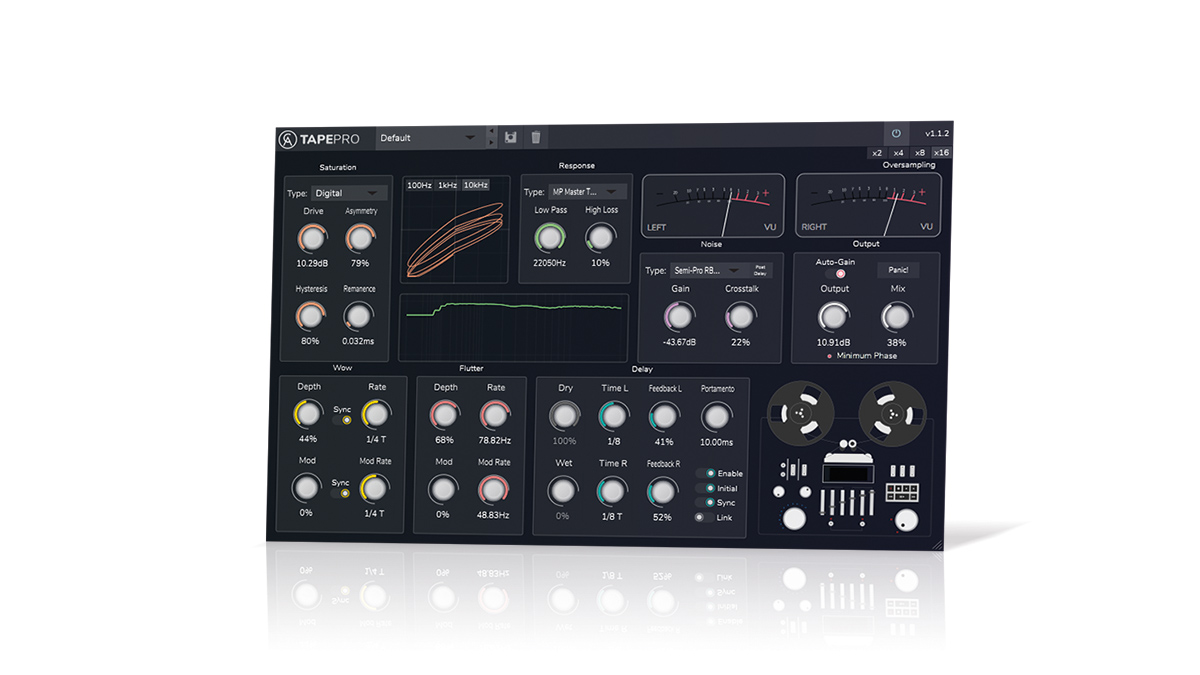MusicRadar Verdict
Tape Pro delivers tape emulation and tape delay effects with plenty of adjustable parameters – all at a great price.
Pros
- +
Decent variety of tape types.
- +
Good visual feedback for distortion and tape curves.
- +
Plenty of adjustable parameters.
- +
Delay option adds a flexible tape delay.
- +
Great price.
Cons
- -
No bypass per module.
- -
Tape noise doesn’t mute in stop mode.
MusicRadar's got your back
What is it?
Fledgling developer Caelum Audio has already impressed with its free cassette tape plugin (now Tape Cassette 2). Its latest endeavour, Tape Pro (VST3, AU), takes the tape concept to the next level, expanding the IR and saturation-based plugin into a fully flexible tape emulation with delay.
Tape Pro is arranged in seven sections – Saturation, Response, Wow, Flutter, Delay, Noise and Output – and has stereo VU-style meters plus an animated open reel tape deck graphic. Two further displays provide feedback for both the saturation curve and tape impulse response, and the latter also shows in real-time the effects of the accompanied High Loss setting.
Tape Pro has two fundamental settings: Saturation Type, for which there are six choices, and tape Response Type, where you’ll find up to 12 options as well as Bypass. The six saturation types (Tape, Digital, Rectify, Half-Rectify, Sine and Smooth) can be modified considerably using the Asymmetry, Hysteresis and Remanence parameters, with overall distortion set with the Drive amount.
Nevertheless, the core types all sound different: from the reasonably-subtle Tape and Smooth options with their predominantly third odd harmonics, via more edgy options (Sine and Digital), to the harmonically-rich Rectify and Half-Rectify.
Performance and verdict
There’s plenty here to add some gentle edge to sounds – we particularly like the Tape setting for bass sounds. If you want to dirty things up, the Rectify options are particularly edgy. The additional parameters take these various shapes to further extremes, but for the most part, these create saturations rather than gritty distortions. This works particularly well with the two Rectify settings, rounding off the harmonics to deliver some lovely buzzy effects.
So what about the tape impulse responses? These come in two sets: a Standard set and a second modified Minimum Phase set. The second set allows you to blend the dry and effected signal with minimal phase issues, and to that end, you’ll find the dry/wet Mix blend only works with the minimum phase impulses.
The impulses include Micro Cassette, Cassette, Semi-Professional and Professional Tape, as well as a few tape delay types (these are not minimum phase) and there’s matching tape hiss options in the Noise section. The impulses cover a lot of ground, making Tape Pro great for both vintage effects and more subtle tape emulation tasks. We particularly like the accompanying high-frequency loss setting for taming transients.
The Wow and Flutter effects further enhance the tape emulation layer, although they’re only really obvious with lower distortion levels. Finally, the inclusion of the Delay section means you can use all these processes to create a massive selection of very authentic tape delays.
Signal flow
Signal flow is important with multi-module effects, and some markings on Tape Pro’s interface would be handy. That said there is a decent signal flow chart in the manual which is well worth checking out. This clarifies that most of the processing (Drive, Asymmetry, Crosstalk, Saturation, Filters, Wow/Flutter, Autogain and wet/dry Mix) comes first.
Next is the tape Impulse response and this feeds the Noise and Delay sections. The Delay can work in two ways and can be before or after the Noise section, and this affects whether the noise joins the delay Wet signal or not.
The default delay mode provides a typical wet/dry blend (the dry signal is tapped after the initial Drive process) and is ideal if you want to use Tape Pro as a tape delay emulation. The other option (Initial) inserts the delay into the saturation chain. With either way, when the delay section is enabled, the signal flow of the whole plugin is slightly different.
Conclusion
So, are there any gripes? First up, there’s no way to bypass each module. This would be very handy to help determine what each section is adding to the whole. Secondly, looking at the analyser, it’s clear the process chain has a built-in high cut, even when no tape impulse is selected. Finally, we found the tape noise is audible when your DAW is stopped; a ‘mute in stationary’ option would be handy. Still, overall, Tape Pro is a very funky plugin with plenty of sonic flavour and an affordable price tag.
MusicRadar verdict: Tape Pro delivers tape emulation and tape delay effects with plenty of adjustable parameters – all at a great price.
Hands-on demos
The GarageBand Guide
Caelum Audio
Specifications
- TYPE: Multi-fx tape audio plugin
- KEY FEATURES: Saturation module, Response module, Noise module, Wow and Flutter module, Delay module
- COMPATIBILITY: VST3 for Windows, AU + VST3 for MacOS, AUv3 + IAA + standalone app for iOS and iPadOS
- CONTACT: Caelum Audio
Computer Music magazine is the world’s best selling publication dedicated solely to making great music with your Mac or PC computer. Each issue it brings its lucky readers the best in cutting-edge tutorials, need-to-know, expert software reviews and even all the tools you actually need to make great music today, courtesy of our legendary CM Plugin Suite.
“I love this version better than mine!!”: Sheryl Crow sings Kelly Clarkson’s praises after watching her cover her breakthrough ‘90s hit
“I’m drawn to melody and drama - AOR and yacht rock”: Tobias Forge says the new Ghost album combines smooth ’80s sounds with Black Sabbath-inspired lyrics
“They perform incredibly well over many decades, just like I have and of course they're incredibly good-looking, just like me”: Alice Cooper launches his own limited edition reel-to-reel tape recorder











